Oticon A S FUBTE01 Hearing Aid Module User Manual
Oticon A/S Hearing Aid Module
User Manual
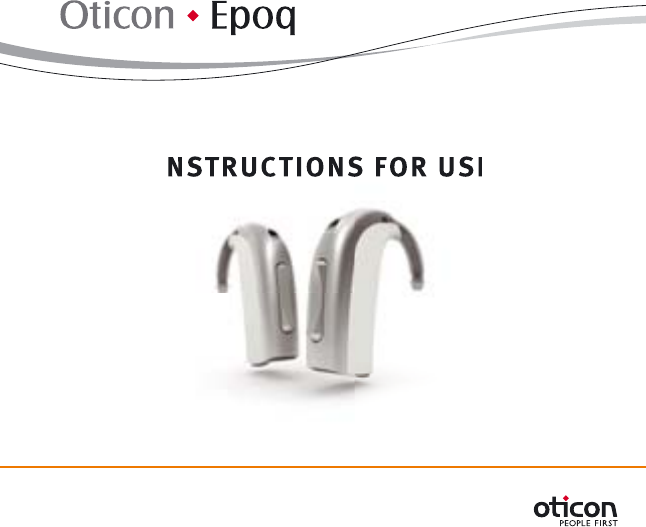
INSTRUCTIONS FOR USE
BTE

Contents
Instrument View BTE 5
Turning your instrument ON and OFF 6
Standby 8
Putting on your instrument 9
Left/Right ear marking 10
Push-button 12
Programs (Optional) 14
Volume Control 16
Changing batteries 18
Tamper-resistant battery door (Optional) 20
Telecoil (Optional) 21
Auto Phone (Optional) 22
DAI (Direct Audio Input) 24
Daily care of your hearing instrument 26
Using your hearing instrument 33
Common problems and their solutions 40
International Warranty 44
Warnings Yellow Pages
Important Notice
Please familiarise yourself with the entire contents
of this booklet before using your hearing instruments.
It contains instructions and important information
about the use and handling of your hearing instruments
and batteries.
Congratulations
We at Oticon would like to take this opportunity to congratulate
you on selecting the most advanced Hearing Instrument on
the market today.
These instructions will help you get the most out of the
instrument and ensure their continued high performance.
Carefully follow these instructions when using and
maintaining them.
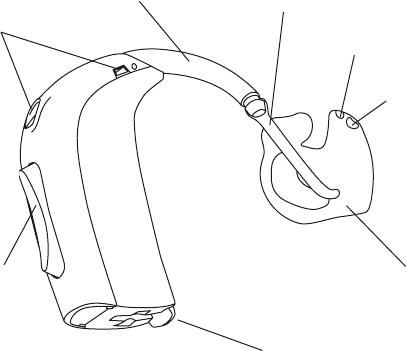
Instrument View BTE
Microphone
Openings
Push-button Earmould
Battery door
Sound Hook Plastic tube
Sound outlet
Ventilation
opening
5
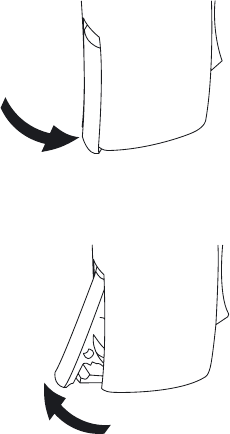
Turning your instrument ON and OFF
Turn ON your hearing instrument by closing the battery door
completely with the battery in place.
When the battery door is closed the instrument will start up
by playing a jingle. This indicates that the battery is working
and the instrument is operating.
Turn OFF your hearing instrument by opening the battery door
slightly until a click is felt.
To preserve the battery, make sure your hearing instrument is
switched off when you are not wearing it.
ON
Click
Click
67
OFF
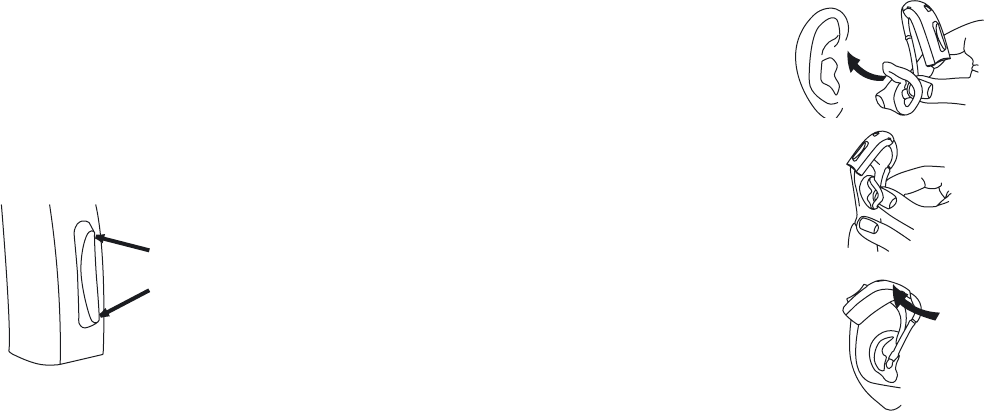
Standby
Push the button for a minimum of 3 seconds to set the
instrument in standby mode.
To reactivate the instrument, push the button shortly again.
Use the standby function if you need to silence the instru-
ment while you have the instrument on.
Push
3 sec
Note: pushing either side of the button will set the instrument
on standby.
A
B
89
Putting on your instrument
Place the tip of the earmould in your
ear canal, twisting slightly, making
sure that the top part of the earmould
(A) is pushed behind and under the
fold (B) of your ear.
Gently pull down your earlope and
press the earmould in the direction
of the ear canal.
With the earmould positioned correctly
in your ear, place the hearing instrument
behind your ear by lifting its lower part
and sliding it over the top of your ear.
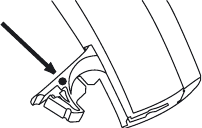
Left/Right ear marking
Hearing instruments are fitted to the uniqueness of each
ear, which means if you have two instruments then your
left hearing instrument is programmed differently from
your right. That is why it is important to distinguish
between the left hearing instrument and the right.
In order to easily identify whether it is left ear or right ear
instrument, colour markings may be applied inside the
battery door.
A blue dot marks the LEFT instrument
A red dot marks the RIGHT instrument
10
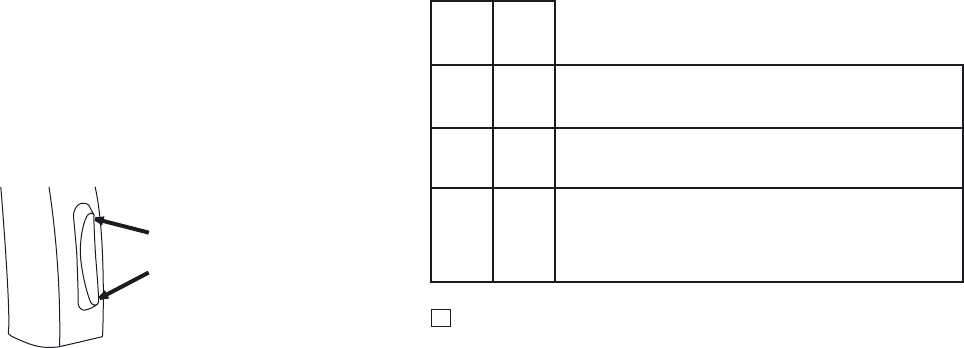
12 13
Left Right
Program shift:
Press shortly to change program
Volume control:
Press shortly to adjust the volume
Both volume control and Program shift:
Press shortly to adjust the volume and press
long (about 2 seconds) to shift program.
Push-button
Your hearing instrument has an ergonomic designed
push- button for volume adjustment and switching
between different programs.
The push-button can be pressed and activated on either
the upper part (UP) or the lower part (DOWN).
UP
DOWN
The push-button on your hearing instrument can be
programmed to one of 3 functionalities.
Binaural Interchangeable enabled
To be filled out by your Hearing Care Professional!
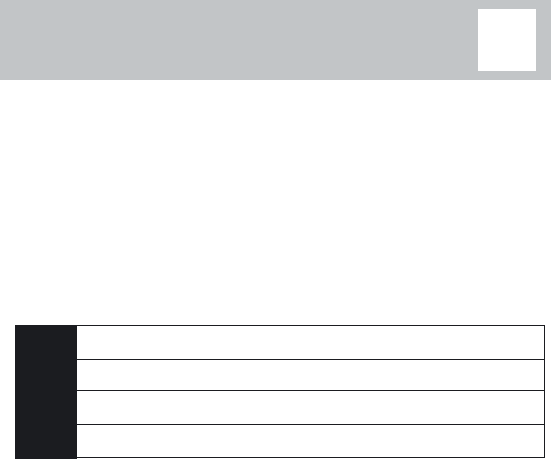
Below you can see a description of the programs available in
your hearing instrument.
Prg. 1: __________________________________
Prg. 2: __________________________________
Prg. 3: __________________________________
Prg. 4: __________________________________
Using 2 instruments
For ease of use, the push-button can be programmed to
change to the equivalent program in the other instrument
also, by using the wireless communication between the
instruments. This is referred as binaural interchange.
You may ask your Hearing Care Professional about the set-up
of your instrument.
Your hearing instrument can have up to 4 different programs.
When switching between the different programs, your hearing
instrument will beep. The number of beeps will indicate
which program you are using.
One beep, when you switch to program 1
Two beeps, when you switch to program 2
Three beeps, when you switch to program 3
Four beeps, when you switch to program 4
e
ee
eee
eeee
14 15
Programs (Optional)

16 17
A volume control may be activated
The volume control allows you to adjust the volume in specific
listening situations to the level you feel comfortable with.
To increase volume, click the upper part of the push-button.
To decrease volune, click the lower part of the push-button.
When max. and min. levels are reached, this is indicated by
2 beeps.
When the hearing instrument is turned on, it starts up at a
preferred volume level. When adjusting the volume control to
the preferred level, this is indicated by a beep.
Volume Control (Optional)
Using 2 instruments
For ease of use, the push-button can be programmed to
adjust the volume in the other instrument equivalently, by
using the wireless communication between the instruments.
This is referred as binaural interchange.
You may ask your Hearing Care Professional about the set-up
of your instrument.
Volume Control (O
p
tional
)
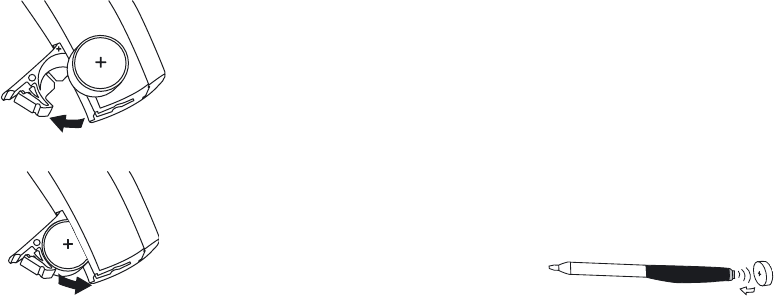
18 19
Changing batteries
Your hearing instrument battery size is 312
A worn out battery should be removed
immediately.
When the battery power is low, you will
hear 2 beeps. This pre-warning starts
when the battery has only a few hours of
operation left. The pre-warning will be
repeated with moderate intervals to indi-
cate it is time to change the battery.
If the battery runs out the instrument
turns off. When that happens, 4 beeps
are played to indicate that the instru-
ment is no longer operating.
It is not an indication of a malfunction.
To replace the battery, follow these instructions:
Open the battery door completely by pushing the raised
edge in the bottom of the instrument. Remove
the old battery.
Remove the sticky label from + side of the new battery.
Insert the new battery so that its + marking faces the + sign
printed on the battery door. Close the battery door.
Any moisture on the battery surface should be wiped off
before use.
When you change battery, it will take a few seconds before
the battery works to full capacity.
To assist the handling of the batteries, the magnet placed at
the end of the tool can be used.
•
•
•

20 21
The hearing instrument may have a build-in telecoil.
The telecoil is a receiver for audio signals transmitted
from an inductive loop installation. The telecoil is meant
for telephone conversations and for loop systems in e.g.
theatres, churches or lecture rooms.
The telecoil is activated by the push-button as switching
between programs. When activated, you will hear a certain
number of beeps corresponding to the telecoil program.
See “Programs” for where the telecoil program is placed.
Tamper-resistant battery door
(Optional)
This is strongly recommended for infants, small children and
people with learning difficulties.
Instructions:
To lock the battery door:
Make sure door is completely closed. Use the screwdriver in
the cleaning tool to turn the tamper-resistant screw to lock’ed
position.
To unlock the batter door:
Use the screwdriver in the cleaning tool to turn the tamper-
resistant screw to un-lock’ed position. The battery door can
be opened as usual.
Telecoil (Optional)
T
amper-resistant
b
attery doo
r
(
Optional
)
Telecoil (O
p
tional
)

22
Auto Phone (Optional)
The Auto Phone is only activated when the hearing instrument
is close to a telephone receiver. If you have a telecoil in your
instrument, the Telecoil Phone program is activated. If you do
not have a telecoil, the Acoustic Phone program is activated.
When the Phone program is activated, you will hear a number
of beeps.
When you end your telephone conversation, the hearing
instrument will automatically return to the previous program.
Not all telephones can activate the Auto Phone. The telephone
receiver needs to have a special magnet fitted. Please follow
the separate instructions for mounting the magnet, which is
available from your Hearing Care Professional.
A
uto Phone (Optional
)
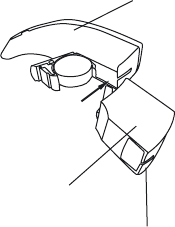
24 25
DAI (Direct Audio Input)
If your hearing instrument is connected by means of a DAI
shoe with an external sound source, like a discman or hand
mic, the signals of these devices will be directly transferred
to your hearing instrument.
.
Mounting of DAI
Start by opening the battery door,
click the DAI shoe onto the instrument.
Then insert the DAI cord into the shoe.
When the DAI shoe is connected, the
instrument will automatically switch
to a combination of a DAI program
and the microphone input of
the instrument.
If you would like the DAI program alone, you can switch
to the next program by using the program switch button.
Two new programs will automatically place themselves after the
standard programs, which have been programmed into your
hearing instrument by your Hearing Care Professional.
Instrument
DAI cord
connector
DAI shoe

Daily care of your hearing instrument
Your ear canal produces ear wax (cerumen) which may clog
up the sound output or the ventilation opening of your
hearing instrument. To prevent wax accumulation causing
a change in performance, the guidelines in this section
should be followed.
When handling a hearing instrument, keep it over a soft
surface to avoid damage if you drop it.
Before retiring at night:
Make sure that there is no ear wax in any of the earmould
openings since it may reduce the hearing instrument’s
effi ciency.
Open the battery door to allow air to circulate.
•
•
26 27
Cleaning the instrument
A range of cleaning tools is prepared for the special purpose
of cleaning the instruments. These should be used to ensure
the best care and performance of your hearing instruments.
BrushCover Handle
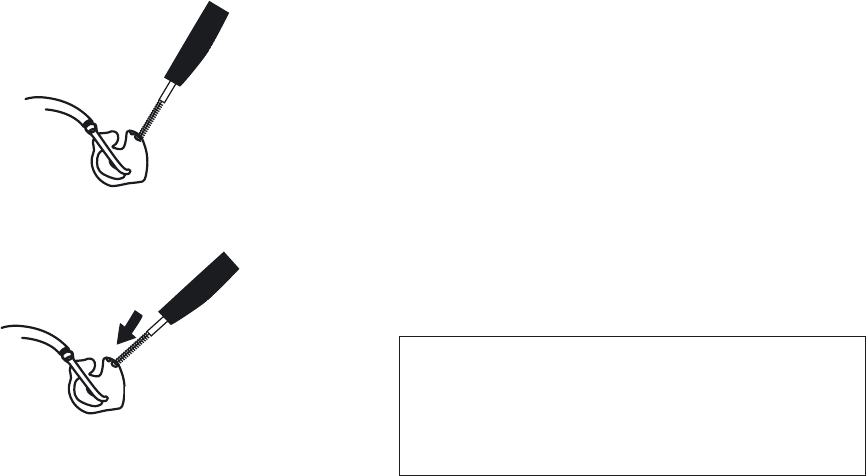
Use the cloth to wipe clean the surface of the instrument.
Replace brush when necessary. Just pull it out of the handle
and insert a new fresh brush. Press the new one firmly into
the handle.
New brushes can be purchased from your local Hearing Care
Professional.
28 29
Important Notice
Open the battery compartment fully to allow
air to circulate whenever you are not using
your hearing instrument, especially at night!
Here’s how
Clean away any traces of wax
from around the sound outlet
with the brush.
•
Clean the ventilation
opening by pressing the
brush through the hole
while twisting it slightly.
•
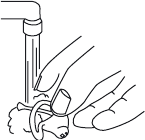
Cleaning the earmoulds
The earmoulds should be washed regularly:
Disconnect the earmould and the tubing from the sound
hook of the hearing instrument.
Wash the earmould in lukewarm water
using a mild soap. Do not use strong
detergents.
Rinse with water.
Dry the earmould
Any water drops inside the earmould or tubing should be
blown out. A special device for this purpose (an earmould
blower) is available from your Hearing Care Professional.
•
•
•
•
•
Make sure the earmould and tubing are completely dry
before they are reconnected to the hearing instrument. Be
careful that left ear earmould and tubing are connected to
the hearing instrument with left ear marking and vice versa
for the right ear instrument.
The hearing instrument itself must never be washed or
immersed in water or other liquids!
Replacing the tubing
The tubing in the earmould should be replaced when it
becomes yellow or stiff. Consult your Hearing Care profes-
sional in relation to this.
•
30 31
32 33
Avoiding heat, humidity and chemicals
Your hearing instrument must never be exposed to extreme
heat e.g. left inside a parked car in the sun. They must never
be exposed to a lot of moisture e.g. steam baths, showers or
heavy rain. Nor must they be dried in microwave ovens or
other ovens.
Wipe the batteries carefully if moisture is present as it may
affect their performance. Using an anti-humidity kit can help
to avoid these problems and may even extend the life of your
hearing instrument. Consult your Hearing Care Professional
for further advice.
The chemicals in cosmetics, hairspray, perfume, after shave
lotion, suntan lotion and insect repellant can damage your
hearing instrument. You should always remove your hearing
instrument before applying such products and allow time
for the product to dry before reinserting your hearing instru-
ment. If you use lotion, be sure to wipe your hands dry before
putting your hearing instrument.
Using your hearing instrument
It takes time to adjust to a new hearing instrument. How
long this adjustment takes differs from person to person.
It will depend on a number of factors, such as whether you
have had a hearing instrument before and the degree of your
hearing loss.
Seven easy steps to better hearing
1. In the quiet of your home
Try to accustom yourself to all the new sounds. Listen to the
many background sounds and try to identify each sound.
Bear in mind that some sounds will seem different from
what you are used to. You may have to learn to identify
them again. Note that in time you will get accustomed to
the sounds in your environment – if not please contact your
Hearing Care Professional.
If using the hearing instrument makes you tired, take them
off for a little while and have a rest. Gradually, you will begin
34 35
to be able to listen for longer periods of time. Soon, you
will be able to wear your hearing instrument comfortably
all day long.
2. Conversation with another person
Sit with someone else in a quiet room. Face each other so
you can read facial expressions easily. You may experience
new speech sounds, which can seem a little disturbing in the
beginning. However, after the brain has adapted to the new
speech sounds, you should hear speech clearer.
3. Listen to radio or TV
When listening to the TV or the radio, start out by listening to
news commentators since they usually speak clearly, then try
other programs.
If you find it difficult to listen to TV or radio, your Hearing
Care Professional should be able to give you advice on
available accessories to enhance your listening capabilities
for TV and radio.
4. In group conversations
Group situations are usually accompanied by a greater
degree of background noise, and are, therefore, naturally
more difficult to cope with. In such situations, therefore,
focus your attention on the person you want to hear. If you
miss a word, ask the speaker to repeat.
5. Telecoil use in church, theatre, or cinema
An increasing number of churches, theatres and public
buildings often have loop systems installed. These systems
send out wireless sound to be received by the telecoil in
your hearing instrument. Typically, a sign will let you know
whether the place has a telecoil. Ask your Hearing Care
Professional for details.
6. Using the telephone
When using the telephone tilt the receiver edge lightly on
your cheek-bone in order to let the sound flow directly into
the hearing aids microphone opening. This way, the hearing
aid will not whistle and you ensure the best conditions to
understand the conversation. When you have the receiver
36 37
in this position, remember to speak directly into the micro-
phone on the telephone in order to ensure good understanding
in the opposite “end of the line”.
If your hearing aid has a telecoil (and your telephone has a
built in tele-loop) you can switch into telecoil program in
order to improve the sound reception further.
Remember that the telecoil in hearing aids may pick up
disturbing signals from electronic devices, such as a fax
machines, computers, televisions or similar. Make sure that
the hearing aid has a distance of 2 - 3 meters to such devices
when using the telecoil program.
7. Wireless and mobile phones
Your hearing instrument is designed to comply with the most
stringent Standards of International Electromagnetic
Compatibility. However not all mobile phones are hearing
instrument compatible. The varying degree of disturbance
can be due to the nature of your particular mobile phone.
If you find it difficult to obtain a good result while using your
mobile telephone, your Hearing Care Professional should be
able to give you advice on available accessories to enhance
listening capabilities.
Use your hearing instrument all day long
The best way to ensure better hearing is to practice listening
until you can wear your hearing instrument comfortably all
day. In most cases, infrequent use of a hearing instrument
does not give you the full benefit. In most cases, you will
not get the full benefit of the hearing instuments if you use
them infrequently.
Your hearing instrument will not restore normal hearing.
Nor will they prevent or improve a hearing impairment
38
resulting from a physiological condition. What they will
give you, however, is help towards making better use of
the hearing ability that you have. If you have two hearing
instruments always wear both.
The most important benefits of wearing two
hearing instruments are:
Your ability to localize sounds will improve.
It will be easier to understand speech in
noisy surroundings.
You will experience a fuller, more comfortable
sound picture.
•
•
•

Common problems and their solutions
Eff ect Cause Solution
No sound
Ear wax accumulated in ear canal
Hearing instrument inserted improperly
Clogged sound outlet
Clogged microphone opening
Worn-out battery
Dirty or corroded battery contacts
Squealing
noise
Have ear canal examined by your doctor
Reinsert hearing instrument (pg. 9)
Clean sound outlet or, if necessary,
have wax protection system changed
by your Hearing Care Professional (pg. 26)
Clean microphone opening with a brush
Replace battery (pg. 18)
Open and close the battery door
several times or replace battery (pg. 18)
40 41

If none of the above solutions solves the problem, ask your
Hearing Care Professional for assistance.
Common problems and their solutions
Eff ect Cause Solution
Dirty or corroded battery
contacts
Dirty or corroded battery
Worn -out battery
Whirring
noise or
beeping
Open and close the battery door
several times or replace battery (pg. 18)
Clean battery surfaces with dry cloth
or replace battery (pg. 18)
Replace battery (pg. 18)
42 43
International Warranty
Oticon hearing instruments are covered by a limited
warranty issued by the manufacturer for a period of 12
months from the date of delivery. This limited warranty
covers manufacturing and material defects in the hearing
instrument itself, but not accessories such as batteries,
tubing, earwax filters etc.
Problems arising from improper handling or care, excessive
use, accidents, repairs made by an unauthorized party,
exposure to corrosive conditions, physical changes in your
ear, damage due to foreign objects entering the device, or
incorrect adjustments are NOT covered by the limited
warranty and may void it.
The above warranty does not affect any legal rights that you
might have under applicable national legis lation governing
sale of consumer goods. Your Hearing Care Professional
may have issued a warranty that goes beyond the clauses
of this limited warranty. Please consult him/her for
further information.
If you need service
Take your hearing instrument to your Hearing Care
Profes sional, who may well be able to sort out minor
problems and adjustments on the spot.
44 45

Product approval, precautions and
markings
The hearing instrument contains a radio transmitter using
short range magnetic induction technology working at 3.714
MHz. The emission power from the radio system is extremely
low and is guaranteed harmless. For comparison, the radia-
tion of the instrument is far less than the radiation generated
by normal electrical installations in your natural environment,
such as light bulbs, electrical wires, etc.
The magnetic field strength of the transmitter is < -5 dBμA/m
@ 10m and complies with all relevant international
standards.
Due to the limited size available on the instruments all rele-
vant approval markings are found in this document.
Oticon Warranty Certifi cate
Name of Owner:
Dispenser:
Dispenser Address:
Dispenser Phone:
Purchase Date:
Warranty Period: Month:
Model Left: Serial no.:
Model Right: Serial no.:
Battery Size:
46 47
906 69 510 00 / 03.07

48 49
Waste from electronic equipment
must be handled according to local
regulations.
0543
ID: U28FUBTE01
IC: 1350B-FUBTE01
The hearing instrument contains a module with:
The device complies with Part 15 of the FCC rules and RSS-210
of Industry Canada.
Operation is subject to the following two conditions:
1. this device may not cause harmful interference
2. this device must accept any interference received,
including interference that may cause undesired
operation.
Changes or modifications made to the equipment not
expressly approved by Oticon may void the FCC’s
authorization to operate the equipment.
Oticon A/S
9, Kongebakken
DK-2765 Smørum
www.hear-it.org
www.oticon.com
906 69 510 00 / 03.07

906 69 510 00 / 03.07
Warnings
Hearing instruments and batteries can be dangerous if
swallowed or used improperly. Such actions can result in
severe injury, permanent hearing loss, or can even be fatal.
You should familiarise yourself fully with the following
general warnings and the entire contents of this booklet
before using your hearing instrument.
Hearing instruments and batteries can be dangerous if
swallowed
Hearing instruments, their parts, and batteries are not toys
and should be kept out of reach of children and anyone
who might swallow these items or otherwise cause injury to
themselves.
Never change the battery or adjust the controls of the hear-
ing instruments in front of infants, small children or people
with learning diffi culties.
•
•
Misuse can result in sudden and permanent
hearing loss
Hearing instruments should be used only as directed and
adjusted by your hearing care professional. Misuse can
result in sudden and permanent hearing loss.
Never allow others to wear your hearing instrument as
incorrect/wrongful usage could cause permanent damage
to their hearing
•
•
Discard batteries carefully in a place where infants, small
children or people with learning diffi culties cannot reach
them.
Batteries have occasionally been mistaken for pills.
Therefore check carefully your medicine before swallowing
any pills.
Never put your hearing instrument or batteries in your
mouth for any reason, as they are slippery and could be
swallowed by accident.
Most Oticon hearing instruments can be supplied with a
tamper-resistant battery compartment upon request. This
is strongly recommended for infants, small children, and
people with learning diffi culties.
If a battery or hearing instrument is swallowed, see a doctor
immediately.
•
•
•
•
Battery use
Always use batteries recommended by your hearing care
professional. Batteries of low quality may leak and cause
bodily harm.
Never attempt to recharge your batteries. They may explode
and cause serious injury.
Never dispose of batteries by burning them. There is a risk
that they will explode and cause serious injury.
Disfunction in hearing instruments
Hearing instruments may stop functioning, for instance if
the batteries have expired or if the tubing is blocked by
moisture or earwax. You should be aware of this possibility,
in particular when you are in traffi c or otherwise dependent
on warning sounds.
•
•
•
•
Interference
Your hearing instrument has been thoroughly tested for
interference, according to the most stringent international
standards. But new technical developments constantly
bring new products into society, and some may emit elec-
tromagnetic radiation, leading to unforeseen interference
in hearing instruments. Examples include induction cooking
appliances, shop alarm systems, mobile telephones, fax
machines, personal computer devices, X-rays, Computer
tomography etc.
•
Possible side eff ects
Hearing instruments may cause an accelerated accumulation
of cerumen (ear wax).
The otherwise non-allergenic materials used in hearing
instruments may in rare cases cause a skin irritation.
Consult a doctor if you experience any of these side effects.
•
•
Safety requirements regarding
Direct Audio Input (DAI)
The safety of hearing instruments with DAI
(Direct Audio Input) is determined by the external signal
source. When the DAI is connected to mains-operated
equipment, this equipment must comply with IEC-60065,
IEC-60601 or equivalent safety standards.
•